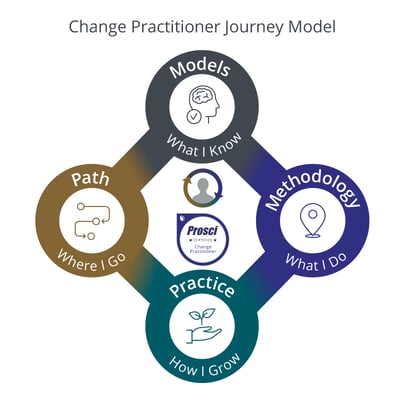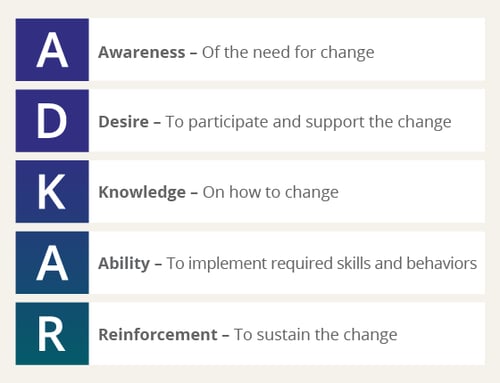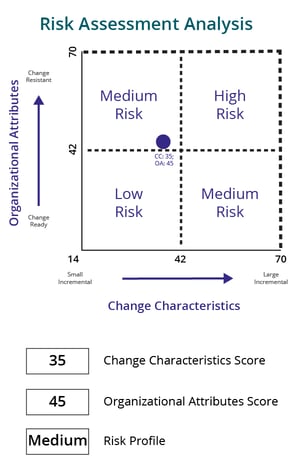How to Grow and Improve as a Change Practitioner

4 Mins
Updated: July 17, 2024
Published: April 12, 2023

Now that you’ve earned Prosci Change Management Certification, how do you start managing your first change in your organization? Although you have the foundation and tools to make an impact on projects, do you really want to start with a complex, global project with a hefty price tag? As a novice, that would be a very risky move.
How to Become a Better Change Manager
To become a change practitioner, you need to have some competency in change management, excellent communications skills, strong interpersonal skills, and flexibility. You may also come to the role with helpful characteristics like knowledge of the business, the ability to influence others, and commitment to the change. But even after earning your change management certification, you may not be ready to fly solo with a project.
Are you struggling to gain momentum for your change? Prosci Advisory Services can help you with role activation, building competency, and more to fuel your journey from Knowledge to Ability.
Prosci Change Practitioner Journey Model
The Change Practitioner Journey Model is a visualization of the process a person goes through to accomplish a goal. This starts with the Models and Methodology you learn in the classroom, where you discover why sponsorship is important, the various core roles in change management, and all the things you do as a practitioner before moving on to Practice and Path.
When you get to Practice, you’re on to growing as a change manager, developing skills and experience, and moving from Knowledge to Ability. Path is about where you want to go in your career as a change management professional and the many ways you can get there.

Improve on Your Change Manager Journey
People get certified in change management for a variety of reasons, but your organization’s goal is clear: you are needed to guide the organization and people through changes, drive adoption and usage, and achieve results. But if your organization is less mature in change management, your change management team is new or less experienced, or you haven’t yet applied the Prosci Methodology and tools to a project, you’re still on your journey from Knowledge to Ability (or K to A).
The Prosci ADKAR Model
You can think of the K-to-A journey like learning to drive a car. You wouldn’t start out with the keys to a Ferrari. First, you learn the rules and techniques in training. You get a learner’s permit and drive with a licensed adult driver for a certain number of hours. You practice driving on highways and at night, making three-point turns, parking on an incline, and driving in inclement weather. And when you pass your exam, you earn a license to drive. But you’re not going to drive in the Indy 500.
The same is true in change management. You need to practice alongside experienced change practitioners on a smaller, lower-risk project. Once you have learned how to be successful at putting a change strategy together, developing an ADKAR Blueprint and some change management plans, conducting assessments, and executing the actions needed, you can move on to a bigger, more complex project. But if you start out with a five-year ERP implementation or big culture change, you’re setting yourself up for failure.
Choose a First Change Management Project
When you start to manage projects, how do you know what type, size and complexity you’re ready for? What do you feel confident taking on? The answer depends on your skills and experience, as well as those of your team. No matter what approach you follow, choose your project thoughtfully to avoid pitfalls.
What kinds of pitfalls? A large project usually comes with a big price tag, so missed deadlines can be very costly. As a novice practitioner, you may not know how to handle resistance and leave out some impacted groups. Extending timeframes and budgets creates opportunity costs in terms of other projects your project teams can’t implement. There are so many nuances to engaging the right stakeholders and influencing them, that you can miss something due to the complexity of how all impacted groups work together and the types of resistance that could lead to project failure.
When you're fresh out of change management training, the most suitable projects to cut your teeth on will score less than 42 on the risk assessment analysis. Projects that score higher are too big, too long, too complex and too risky for a first project. Remember, your goal is to advance the project, but you’re also building capability and confidence as a practitioner and moving from K to A.

You can choose an appropriate change management project by completing the following steps:
- Assess your experience and skills with managing change.
If you’re a novice practitioner with a background in project management or human resources, you probably have more change-enabling skills than someone who worked in operations, for example. - Consider a few changes that could be appropriate.
Look for projects that are lower in risk, costs and complexity, and can be completed in a shorter time frame. Which are the best fit for where you are on your journey today? - Assess the tools needed for your change.
Novice practitioners tend to simply follow the change management process, using every tool without discretion. For example, your change may need only an ADKAR Blueprint instead of all the Core and Extend Change Management Plans. - Determine the coaching and support you need.
What areas will you need help with? Are you comfortable with creating communications but less secure with understanding root causes of resistance in impacted groups? Find someone you can turn to for guidance when you hit roadblocks. - Choose and execute a demonstration project.
The ideal project should help you build capabilities while highlighting K-to-A gaps in your skillset to bridge over time.
As you grow on your K-to-A journey by managing more changes, you want to learn how to translate your successes to new and different project types. Can you translate your success on a software rollout to a culture change or an organizational merger? Can you find ways to improve your influencing skills? How do you grow the softer skills, including change leadership?
Become a Better Change Manager
The Prosci Change Management Certification Program is an exciting step forward on your practitioner journey. After you learn the models, methodology, tools and processes in the classroom, then pass your exam and earn your Prosci Certified Change Practitioner badge, you’re ready to start working on projects. Approaching your growth thoughtfully with the right guidance will help you close the K-to-A gap and grow to become an expert change leader in your organization.


